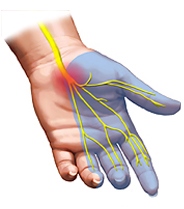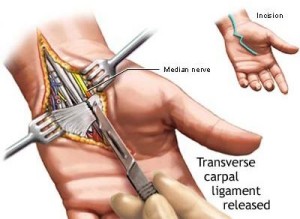Introduction
- Carpal tunnel syndrome (CTS) occurs when the median nerve serving the hands and fingers is compressed as it threads through the wrist’s carpal tunnel structure.
- While a specific cause is rarely discovered, a common factor among patients involves repetitive wrist motion, such as the forceful grasping and movement of tools or other objects.
- Numerous medical conditions are associated with CTS, including pregnancy, use of contraceptive pills, menstrual cycles, vitamin B6 deficiency, hemodialysis, rheumatoid arthritis, obesity, amyloidosis, acromegaly and myxedema.
- CTS is more common in women than men with onset of symptoms typically between age 40 and 60.
Symptoms
- The primary symptoms are aching, burning, tingling, and numbness in the hands in the region of the thumb and first two fingers.
- The pain typically is worse at night. On awakening, the patient may have to shake the hand or massage the wrist to obtain relief.
- Strenuous use of the hand nearly always aggravates symptoms.
- Other symptoms include weakness or clumsiness in the hand.
Diagnosis
- Two tests are used to distinguish CTS from cervical root abnormalities and tendonitis.
- A nerve conduction velocity (NCV) test involves electrical stimulation of the nerve to measure the speed of response.
- Electromyogram (EMG) measures the physiological properties of muscles during movement and at rest.
Treatment
- If symptoms are mild or intermittent, short in duration and likely reversible, conservative treatment with rest, a wrist splint and/or anti-inflammatory medication is recommended.
- Surgical treatment is available if conservative treatment fails to offer sustained improvement, electrodiagnostic data confirms CTS, and/or sensory loss, atrophy or weakness is present.
- Surgery involves careful sectioning of the transverse carpal ligament under local anesthesia.








